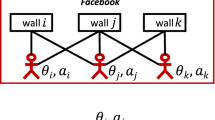Abstract
Facebook is becoming a pervasive entity as its social, cultural and media ramifications grow deep and entrenched in our daily life. Its nature of a complex system of interactions, bearing a strong similarity to networks built through individual choices and systems shaped by evolutionary pressure, makes it an interesting target for research. Scale-free Small World networks, recently popularized by Barabasi, are a topological class pertaining to both these domains, whose members have resilience to disruption and short intermediate connections between nodes. In this paper we show that the topological structure of a specific subset of Facebook, gathered using data from a self-report online questionnaire on its usage, is similar but measurably different from a scale-free Small World network. We conjecture that the reason for this counterintuitive result lies in the dynamics behind friendship requests. This concept may be extendable to the whole network and to other social networks, and is useful to understand Facebook strengths and weaknesses, and to forecast its evolution.


Similar content being viewed by others
References
Albert R, Barabasi AL (2002) Statistical mechanics of complex networks. Rev Mod Phys 74(47):47–97
Barabasi AL (2001) The physics of the web, Physics Web, The IoP Webpage
Barabasi AL (2002) Linked: the new science of networks. Perseus, Cambridge
Bhattacharyya P, Garg A, Wu S (2011) Analysis of user keyword similarity in online social networks. Soc Netw Anal Mining (1):143–158. doi:10.1007/s13278-010-0006-4
Blackmore S (2001) Evolution and memes: the human brain as a selective imitation device. Cybern Syst 32:225–255
Bollobas B (2001) Random graphs. Cambridge University Press, Cambridge
Boyd DM, Ellison NB (2008) Social network sites: definition, history, and scholarship. J Comput Mediat Commun 13:210–230
Chatfield C (1983) Statistics for technology. Chapman and Hall
Cucchiarelli A, D’Antonio F, Velardi P (2011) Semantically interconnected social networks. Soc Netw Anal Mining 1–27. doi:10.1007/s13278-011-0030-z
Dawkins R (1976) The selfish gene. Oxford University Press, Oxford
Donath J, Boyd D (2004) Public displays of connection. BT Tech J 2(4):71–82
Dwyer C, Hiltz S, Passerini K (2007) Trust and privacy concern within social networking sites: a comparison of Facebook and MySpace. In: Proceedings of the thirteenth Americas conference on information systems, Keystone, Colorado August 09–12
Ellison N, Heino R, Gibbs J (2006) Managing impressions online: self-presentation processes in the online dating environment. J Comp Med Comm 11(2):415–441
Feng F, Lianghuan L, Long W (2008) Empirical analysis of online social networks in the age of Web 2.0. Phys A Stat Mech Appl 387(2–3):675–684
Golder SA, Wilkinson D, Huberman BA (2007) Rhythms of social interaction: messaging within a massive online network. In: Proceedings of the Third international conference on communities and technologies. Springer, London, pp 41–66
Hargittai E (2007) Whose space? Differences among users and non-users of social network sites. Comp Med Comm 13(1):article 14
Joinson AN (2008) Looking at, looking up or keeping up with people? Motives and use of Facebook. In: Proceedings of CHI ’08. ACM, New York, pp 1027–1036
Koslow S, Hyman S (2000) Human brain project: a program for the new millennium, Einstein Quarterly. J Biol. Med 17:7–15
Lampe C, Ellison NB, Steinfield C (2006) A Face(book) in the crowd: social searching vs. social browsing. In: Proceedings of CSCW’06. ACM, New York, pp 167–170
Lenhart A, Madden M (2007) Teens, privacy and online social networks: how teens manage their online identities and personal information in the age of MySpace. Pew Internet and American Life Project. http://www.pewinternet.org/PPF/r/211/report_display.asp. Accessed July 7, 2011
Lyon B (2003) The opte project. http://www.opte.org
Petrou M, Piroddi R, Tabacchi ME (2010) Networks of concepts and ideas. Comput J 53(10):1738–1751
Scott J. (2011) Social network analysis: developments, advances, and prospects Soc Netw Anal Mining 1:21–26. doi:10.1007/s13278-010-0012-6
Tufekci Z (2008) Grooming, gossip, Facebook and MySpace: what can we learn about these sites from those who won’t assimilate? Inf. Comm. Soc. 11(4):544–564
Watts DJ, Strogatz SH (1998) Collective dynamics of ‘small world’ networks. Nature 393:440–442
Zhang W, Wu W, Wang F, Xu K (2011) Positive influence dominating sets in power-law graphs. Social Netw Anal Mining 1–7. doi:10.1007/s13278-011-0033-9
Acknowledgment
The authors wish to thank Valerio Perticone for his help with data mining.
Author information
Authors and Affiliations
Corresponding author
Rights and permissions
About this article
Cite this article
Caci, B., Cardaci, M. & Tabacchi, M.E. Facebook as a Small World: a topological hypothesis. Soc. Netw. Anal. Min. 2, 163–167 (2012). https://doi.org/10.1007/s13278-011-0042-8
Received:
Revised:
Accepted:
Published:
Issue Date:
DOI: https://doi.org/10.1007/s13278-011-0042-8




